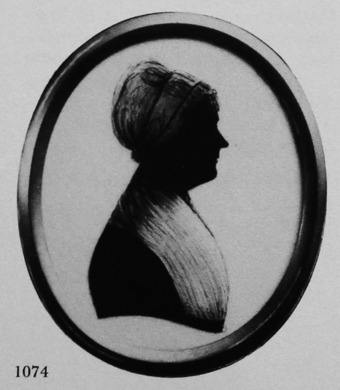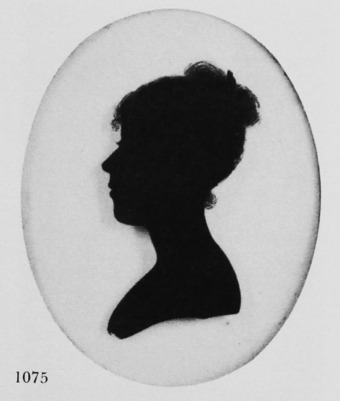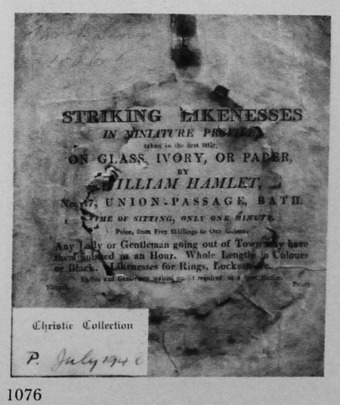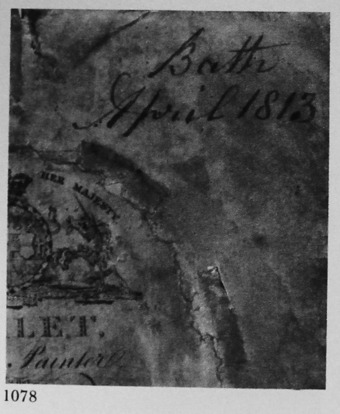Hamlet, William, the Younger (McKechnie Section 3)
See also Sections Two and Six
Although I have seen more work by this artist on paper than on glass, I have, for convenience, made this the main entry on him, immediately following that on William Hamlet the elder.
The year of Hamlet's birth can be deduced from the following obituary notice (Bath Chronicle, 6 November 1815): 'On Monday last, died Mr. Wm. Hamlet, profile painter, at No. 2, Old Bond Street, in his thirty-sixth year.' it is clear from this that Hamlet was born in 1779. I have suggested in the entry in this Section on William Hamlet the elder that his family may have originated in France. It is probable that the younger Hamlet was his son, and may have been born in France.
The appearance of silhouettes which can be attributed to the younger Hamlet suggest that he was not working before 1800. He was certainly in Bath by 1801, for it is recorded in the registers of St Michael's parish church that on 10 August of that year 'William Hamlett' married Jane Fox, the wedding being witnessed by Robert Higginbotham and C. Russell.
An example inscribed 'W. Hamlet, Junr', painted in full-length on glass, was sold by Sotheby and Company, London, in January 1972. This silhouette, which appears to date from 1804-5, bears the address 9 Union Passage (Bath). This is the earliest extant example which I have seen. Another profile on glass (bust-length, in the Christie collection), dated 1806, can be attributed to the younger Hamlet; it bears Trade Label No. 1 (without the Royal coat-of-arms, which appears on some of the eider Hamlet's trade labels), as does a profile on card obviously not by the elder artist, illustrated in Chapter Five. 128
It seems that both Hamlets worked at 17 Union Passage from c. 1805 until c. 1810-11, when they moved (before about June 1811; see William Hamlet the elder) to 12 Union Street. The younger Hamlet may have visited Weymouth c. 1806-1807, when the elder Hamlet is believed to have visited this town.
References in directories and Bath guides, given in the entry on the elder Hamlet, tell us little about the younger artist, who, however, was probably working in Union Street until 1815. I have been told of a silhouette on glass, of `Mrs. Smith, 1815', inscribed in the same hand as the inscriptions on the profiles of Captain O'Malley and Mr. and Mrs. Smith illustrated in Section Six. 1534, 1535, 1536
We know that Hamlet had moved to 2 Old Bond Street, Bath, by May 1815, for there is in the Victoria and Albert Museum, London, a print of a silhouette of a Mr. George Broward, bearing the name William Hamlet, the Old Bond Street address, and this date. Hamlet lived for less than a year at this address, but during this time used two printed trade labels: No. 2, seen on the reverse of two silhouettes owned by the National Trust, and No. 3, on a portrait miniature owned by Mrs. E. De Peyer. We can state with certainty only that Hamlet was at 2 Old Bond Street by May 1815, and, as the obituary quoted above tells us, that he died there in November of that year.
There is a note in the Victoria Art Gallery, Bath, to the effect that one of the Hamlets was a pupil of John Dixon, the miniature painter and silhouette artist (see Section Two). It seems likely that this note refers to the younger Hamlet, who offers coloured work on all three of his trade labels, and whose later work (in colour; see Section Six) shows a marked improvement on his earlier productions.
Bust-length work on glass by Hamlet the younger can be distinguished from the elder Hamlet's work by its inferior quality and variable style. The younger Hamlet used transparency, with detail executed by hatching, but it is of coarser quality than that of the older artist. The younger Hamlet's bust-line terminations show much more variation than the older artist's. Two bust-length silhouettes are illustrated. Another, of Elizabeth Barnard, taken at 2 Old Bond Street in 1815, was sold from the collection of Sir Henry Sutcliffe Smith by Blairman of London in 1948. The painting of this example may have been of a higher standard than that of the illustrated pieces, which were probably painted before Hamlet took lessons from John Dixon (possibly c. 1811).
I have seen only one full-length silhouette on glass signed by the younger Hamlet. This was a double portrait of Lord and Lady (?) Orford. Although the style of painting was similar to that of the elder Hamlet, this piece showed neither the panache nor the finesse achieved by the latter in silhouettes of a similar type. The hatching over the transparency on the woman's gown, and on her companion's breeches, showed less skill. One of Lord Orford's feet is shown over-size, and the plume on the military headdress (he is in uniform) is painted with inadequate detail. The figures stand on a wash base (partly transparent, as are the bases seen on the elder Hamlet's work). In order to indicate that the subjects were represented out of doors, the artist painted groups of leaves, intended to represent plants and grasses and scattered at random about the base. Later full-length work than this must, presumably, exist.
Two side-lines of Hamlet's (see Trade Labels Nos. 2 and 3) were the sale of `prepared ivories for miniature painting' and of frames for miniatures.
It should be borne in mind that silhouettes and profile miniatures by the younger Hamlet (possibly dating from c. 1806-1815) were sold bearing either printed or handwritten trade labels of the elder Hamlet (q.v. for a discussion of these labels). Three printed trade labels of William Hamlet the younger himself are known. No. 1 was used at 17 Union Passage, Bath, c. 1806:
STRIKING LIKENESSES
IN MINIATURE PROFILE
taken in the first Stile
ON GLASS, IVORY OR PAPER
By
WILLIAM HAMLET
No. 17, UNION-PASSAGE, BATH.
Time of sitting only One Minute.
Price from Five Shillings to One Guinea.
Any Lady or Gentleman going out of Town may have them finished in an Hour. Whole Lengths in Colours or Black. Likenesses for Rings, Lockets, &c.
Ladies and Gentlemen waited on if required at a short Notice
I have seen no silhouette attributable to the elder Hamlet backed with this label.
Trade Label No. 2 (illustrated) was used for a short time in 1815 at 2 Old Bond Street, Bath. It reads:
HAMLET
Miniature and Profile Painter
To Her Majesty and the Royal Family
No 2, Old Bond-Street
BATH.
Takes the most STRIKING LIKENESSES on
Glass, Paper & Ivory.
A SITTING OF ONLY ONE MINUTE REQUIRED
LARGE SHADES reduced to any Size
PROFILES in BLACK from 2s. 6d to £1 ls.
COLOURED from lOs 6d. to £3. 3s.
Prepared ivories for Miniature Painting and Miniature
Frames for Sale
Ladies and Gentlemen waited on.
There is an example of Trade Label No. 3 (another label, used during 1815, which bears the address 2 Old Bond Street) on a three-quarter-face portrait miniature of a man, well painted against a competently hatched background of a cloudy sky, owned by Mrs. E. De Peyer. This label is headed with the words `PATRONIZED BY HER MAJESTY', printed in an oval around the Royal coat-of-arms. Beneath the coat-of-arms is printed the following text:
HAMLET
Miniature and Profile Painter
to Her Majesty
and the Royal Family.
No. 2. OLD BOND STREET,
BATH.
Takes the most Striking Likenesses
on Glass, paper, or ivory
A SITTING OF ONLY ONE MINUTE
Large Shades reduced to any size.
PROFILES IN BLACK, from 2s. 6d. to £1. ls.
COLOURED from 10s. 6d. to £3. 3s.
Prepared ivories for painting, and
miniature frames for Sale.
Ladies and Gentlemen waited upon.
Wood & Co. City Printing Office, Bath.
It is impossible to say whether this label was in use earlier or later than Trade Label No. 2, as Hamlet stayed at 2 Old Bond Street for such a short time.
Two handwritten inscriptions of Hamlet are known. One, seen on a full length profile on glass, sold by Sotheby and Company, London, in January 1971, reads, 'Drawn by/W. Hamlet Junr./No. 9, Union Passage/Bath'. It is this inscription which enables us to identify the younger Hamlets handwriting, seen on the silhouette painted on glass (1815) discussed above and on work discussed in Section Six. The other inscription (illustrated) dates from 1813.
Ills. 1074-1078

Sarah Linvey
Silhouette painted on convex glass
1806
3 x 2½in./77 x 64mm.
Trade Label No. 1
Frame: papier mâché
M. A. H. Christie collection

Miss Elizabeth Tydell
Silhouette painted on convex glass
1810
2 ¾ x 2 ¼ in./70 x 58mm.
Trade Label No. 3 (William Hamlet the elder)
Frame: papier mâché
Attributed to Hamlet the younger on stylistic grounds.
Crown Copyright. Victoria and Albert Museum, No. P.132-1922

Trade Label No. 1 of William Hamlet the younger, from the silhouette in 1074.
M. A. H. Christie collection

Trade Label No. 2 of William Hamlet the younger.
From Dyrham Park, by courtesy of National Trust

Inscription of William Hamlet the younger, from the silhouette shown in 1536.
Author’s collection
